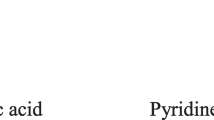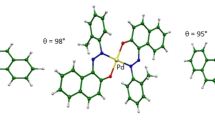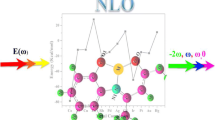Abstract
A series of acridine-based PNP and PNF pincer containing Ru and Rh transition metal complexes have been explored. A theoretical investigation has been performed to examine the electronic structure, absorption and possible remote interaction of the fluorine atom connected to the acridine ligand with the metal centre employing DFT and TDDFT calculation. Bader’s Atoms in Molecules Theory is additionally applied for the studied complexes to evaluate the bonding nature between metal and F. For all the studied complexes, the LUMOs mainly consist of the acridine π* orbitals. HOMOs primarily consist of metal d orbitals. On that account, a metal-to-ligand charge transfer transition is possible in these complexes. The analysis of UV–Vis absorption spectra demonstrates how attached ligands affect electronic transitions. All of the complexes display two main transitions. The lowest energy band is due to the HOMO–LUMO MLCT transition between metal d orbitals and acridine π* orbitals. The topological analysis demonstrates a strong interaction between the metal atom and the F atom. Even so, positive Laplacian of electron density observed at the bond critical point between metal and F denied the possibility of covalent-type interaction.
Graphical abstract







Similar content being viewed by others
References
An B, Feng S, Wen K, Wu W, Yuan H, Zhu Q, Guo X, Zhang J (2017) Theoretical insights into the ultrafast excited-state intramolecular proton transfer (ESIPT) mechanism in a series of amide-based NH⋯N hydrogen-bonding compounds. Org Electron 45:1–8
Arashiba K, Miyake Y, Nishibayashi Y (2011) A molybdenum complex bearing PNP-type pincer ligands leads to the catalytic reduction of dinitrogen into ammonia. Nat Chem 3(2):120–125
Awada A, Moreno-Betancourt A, Philouze C, Moreau Y, Jouvenot D, Loiseau F (2018) New Acridine-Based tridentate ligand for Ruthenium(II): Coordination with a twist. Inorg Chem 57(24):15430–15437
Ayala R, Galindo A (2019) A QTAIM and DFT study of the dizinc bond in non-symmetric [CpZn2Ln] complexes. J Organomet Chem 898:120878
Bine FK, Nkungli NK, Numbonui TS, Numbonui Ghogomu J (2018) Structural properties and reactive site selectivity of some transition metal complexes of 2,2′(1E,1′E)-(ethane-1,2-diylbis(azan-1-yl-1-ylidene))bis(phenylmethan-1-yl-1-ylidene)dibenzoic Acid: DFT, conceptual DFT, QTAIM, and MEP studies. Bioinorg Chem Appl 2018:4510648
Bootsma J, Guo B, de Vries JG, Otten E (2020) Ruthenium complexes with PNN pincer ligands based on (Chiral) pyrrolidines: synthesis, structure, and dynamic stereochemistry. Organometallics 39(4):544–555
Buschmann H-J, Hermann J, Kaupp M, Plenio H (1999) The coordination chemistry of the CF group of fluorocarbons: thermodynamic data and Ab initio calculations on CF-metal ion interactions. Chem : a European J 5(9):2566–2572
Cao J, Zhou Y (2017) Excited state relaxation processes of H2-evolving Ru-Pd supramolecular photocatalysts containing a linear or non-linear bridge: a DFT and TDDFT study. Phys Chem Chem Phys 19(18):11529–11539
Catala RM, Cruz-Garritz D, Sosa P, Terreros P, Torrens H, Hills A, Hughes DL, Richards RL (1989) Ruthenium-X-carbon (X = F or H) interactions in complex compounds. preparation and crystal structures of [cyclic] [Ru[SC6F4(F-2)](SC6F5)2(PMe2PhH)2] and [cyclic] [Ru(SC6F5)2[PC6H4(H-2)(C6H5)2]2]. J Organomet Chem 359(2):219–232
Chai J-D, Head-Gordon M (2008) Long-range corrected hybrid density functionals with damped atom–atom dispersion corrections. Phys Chem Chem Phys 10(44):6615–6620
Clot E, Eisenstein O, Jasim N, Macgregor SA, McGrady JE, Perutz RN (2011) C−F and C−H bond activation of fluorobenzenes and fluoropyridines at transition metal centers: How fluorine tips the scales. Acc Chem Res 44(5):333–348
Doherty NM, Hoffmann NW (1991) Transition-metal fluoro compounds containing carbonyl, phosphine, arsine, and stibine ligands. Chem Rev 91(4):553–573
Doro FG, Ferreira KQ, da Rocha ZN, Caramori GF, Gomes AJ, Tfouni E (2016) The versatile ruthenium(II/III) tetraazamacrocycle complexes and their nitrosyl derivatives. Coord Chem Rev 306(2):652–677
Fantacci S, De Angelis F, Sgamellotti A, Re N (2004) A TDDFT study of the ruthenium(II) polyazaaromatic complex [Ru(dppz)(phen)2]2+ in solution. Chem Phys Lett 396(1–3):43–48
Fleckhaus A, Mousa AH, Lawal NS, Kazemifar NK, Wendt OF (2015) Aromatic PCN palladium pincer complexes. probing the hemilability through reactions with nucleophiles. Organometallics 34(9):1627–1634
Frisch MJ, Trucks GW, Schlegel GW, Scuseria GE, Robb MA, Cheeseman JR, Scalmani G, Barone V, Petersson GA, Nakatsuji H, Li X, Caricato M, Marenich AV, Bloino J, Janesko BG, Gomperts R, Mennucci B, Hratchian HP, Ortiz JV, Izmaylov AF, Sonnenberg JL, Williams, Ding F, Lipparini F, Egidi F, Goings J, Peng B, Petrone A, Henderson T, Ranasinghe D, Zakrzewski VG, Gao J, Rega N, Zheng G, Liang W, Hada M, Ehara M, Toyota K, Fukuda R, Hasegawa J, Ishida M, Nakajima T, Honda Y, Kitao O, Nakai H, Vreven T, Throssell K, Montgomery VG Jr., Peralta JE, Ogliaro F, Bearpark JE, Heyd JJ, Brothers EN, Kudin KN, Staroverov VN, Keith TA, Kobayashi R, Normand J, Raghavachari K, Rendell AP, Burant JC, Iyengar SS, Tomasi J, Cossi M, Millam JM, Klene M, Adamo C, Cammi R, Ochterski JW, Martin RL, Morokuma K, Farkas O, Foresman JB, Fox DJ (2016). Gaussian 16 Rev. C01 Wallingford, CT
Fuchs E, Egen M, Kahle K, Lennartz C, Molt O, Nord S, Kowalsky W, Schildknecht C, Johannes H-H (2007) Heteroleptic cyclometalated transition metal-carbene complexes containing at least two differently substituted N-heterocyclic carbene ligands and their use in organic light-emitting diodes (OLEDS). BASF Aktiengesellschaft, Germany, p 88
Funasako Y, Kaneshige K, Inokuchi M, Hosokawa H, Mochida T (2015) Ionic liquids containing cationic SNS-pincer palladium(II) complexes: Effects of ancillary ligands on thermal properties and solvent polarities. J Organomet Chem 797:120–124
Gao Y, Yip JHK (2019) Selective Hypochlorous Acid Detection by Electronic Tuning of Platinum-4,5-bis(diphenylphosphino)acridine-Thiolate Complexes. Inorg Chem 58(14):9290–9302
Gao X, Shi S, Yao J-L, Zhao J, Yao T-M (2015) Impacts of terminal modification of [Ru(phen)2d ppz]2+ on the luminescence properties: a theoretical study. Dalton Trans 44(44):19264–19274
Ghosh B, Naskar S, Naskar S, Espinosa A, Hau SCK, Mak TCW, Sekiya R, Kuroda R, Chattopadhyay SK (2014) Heteroleptic Ru(II) complexes containing aroyl hydrazone and 2,2’-bipyridyl: synthesis, X-ray crystal structures, electrochemical and DFT studies. Polyhedron 72:115–121
Granados JAO, Hernandez JG, Huerta-Aguilar CA, Thangarasu P (2018) Exploration of ruthenium complex of (E)-2-((pyridine-2-yl)methyleneamino) benzoic acid as chemosensor for simultaneous recognition of acetate and HSO4- ions in cell bio-imaging: Experimental and theoretical studies. Sens Actuators B-Chem 270:570–581
Guadalupe Hernández J, Thangarasu P (2021) A critical evaluation of [ML(ONO)]n+ (M = Fe, Ru, Os) as nitric oxide precursor influenced by spin multiplicity and geometrical parameters (M-O-NO and MO-N-O) for the NO release: A theoretical study. Inorg Chim Acta 527:120584
Gunanathan C, Gnanaprakasam B, Iron MA, Shimon LJW, Milstein D (2010) “Long-Range” metal−ligand cooperation in H2 activation and ammonia-promoted hydride transfer with a Ruthenium−Acridine pincer complex. J Am Chem Soc 132(42):14763–14765
Hernandez JG, Thangarasu P, Hopfl H, Cruz J, Serrano-Ruiz M, Romerosa A (2015) Ruthenium(II) complexes containing benzimidazolic tripodal ligands. Inorg Chim Acta 431:258–265
Hernandez JG, Narayanan J, Hernandez EG, Thangarasu P (2021) Understanding of [RuL(ONO)]n+ acting as nitric oxide precursor, a theoretical study of ruthenium complexes of 1,4,8,11-tetraazacyclo- tetradecane having different substituents: How spin multiplicity influences bond angle and bond lengths (Ru-O-NO) in releasing of NO. J Inorg Biochem. https://doi.org/10.1016/j.jinorgbio.2021.111406
Hernández-Hernández J, Huerta Aguilar CA, Thangarasu P, Hernández-Trujillo J (2019) Photochemical and antibacterial properties of ruthenium complex of N, N´-bis(benzimidazole-2yl-ethyl)ethylene-diamine under visible light: Experimental and theoretical studies. J Mol Struct 1203:127377
Himmelbauer D, Mastalir M, Stoeger B, Veiros LF, Kirchner K (2018) Synthesis and reactivity of group six metal PCP pincer complexes: reversible CO addition across the metal-caryl bond. Organometallics 37(20):3631–3638
Hughes RP (1990) Organo-Transition metal compounds containing perfluorinated ligands. advances in organometallic chemistry. F. G. A. stone and R. West, Academic Press 31:183–267. https://doi.org/10.1016/S0065-3055(08)60511-0
Karaush NN, Baryshnikov GV, Minaeva VA, Minaev BF (2015) A DFT and QTAIM study of the novel d-block metal complexes with tetraoxa[8]circulene-based ligands. New J Chem 39(10):7815–7821
Kendall RA, Dunning TH, Harrison RJ (1992) Electron affinities of the first-row atoms revisited. Systematic basis sets and wave functions. J Chem Phys 96(9):6796–6806
Kiplinger JL, Richmond TG, Osterberg CE (1994) Activation of Carbon-Fluorine bonds by Metal Complexes. Chem Rev 94(2):373–431
Kulawiec RJ, Crabtree RH (1990) Coordination chemistry of halocarbons. Coord Chem Rev 99:89–115
Kulawiec RJ, Holt EM, Lavin M, Crabtree RH (1987) Chelation of a carbon-fluorine bond to iridium in an 8-fluoroquinoline complex. Inorg Chem 26(15):2559–2561
Kupfer S, Guthmuller J, Wächtler M, Losse S, Rau S, Dietzek B, Popp J, González L (2011) Protonation effects on the resonance Raman properties of a novel (terpyridine)Ru(4H-imidazole) complex: an experimental and theoretical case study. Phys Chem Chem Phys 13(34):15580–15588
Lawrence MAW, Green K-A, Nelson PN, Lorraine SC (2018) Review: Pincer ligands—Tunable, versatile and applicable. Polyhedron 143:11–27
Le L, Liu J, He T, Kim D, Lindley EJ, Cervarich TN, Malek JC, Pham J, Buck MR, Chianese AR (2018) Structure-Function Relationship in Ester Hydrogenation Catalyzed by Ruthenium CNN-Pincer Complexes. Organometallics 37(19):3286–3297
Li Y, Fan X-W, Wang J, Kong C-P, Chen J, Wang S-P, Li H-C, Bai F-Q, Zhang H-X (2020a) Comparative study on the photophysical properties between carbene-based Fe (II) and Ru (II) complexes. Appl Organomet Chem 34(10):e5821
Li Y, Fan XW, Wang J, Kong CP, Chen J, Wang SP, Li HC, Bai FQ, Zhang HX (2020b) "Comparative study on the photophysical properties between carbene-based Fe (II) and Ru (II) complexes. Appl Organomet Chem. https://doi.org/10.1002/aoc.5821
Liu C-S, Chen P-Q, Yang E-C, Tian J-L, Bu X-H, Li Z-M, Sun H-W, Lin Z (2006) Silver(I) complexes in coordination supramolecular system with bulky acridine-based ligands: syntheses, crystal structures, and theoretical investigations on C−H···Ag Close Interaction. Inorg Chem 45(15):5812–5821
Lobello MG, De Angelis F, Fantacci S (2014) A computational approach to the electronic, optical and acid-base properties of Ru(II) dyes for photoelectrochemical solar cells applications. Polyhedron 82:88–103
Lu T, Chen F (2012) Multiwfn: A multifunctional wavefunction analyzer. J Comput Chem 33(5):580–592
Malthus SJ, Wilson RK, Larsen DS, Brooker S (2016) Acridine-based ligands from cobalt(II) mediated rearrangement of diphenylamine-based starting materials. Supramol Chem 28(1–2):98–107
Martynow M, Kupfer S, Rau S, Guthmuller J (2019) Excited state properties of a series of molecular photocatalysts investigated by time dependent density functional theory. Phys Chem Chem Phys 21(18):9052–9060
Matsheku AC, Chen MYH, Jordaan S, Prince S, Smith GS, Makhubela BCE (2017) Acridine-containing RuII OsII, RhIII and IrIII half-sandwich complexes: synthesis, structure and antiproliferative activity. Appl Organomet Chem 31(12):3852
May A, Ouddai N (2012a) Topological analysis of the bonding in [Ru5(μ4-C2)L(CO)13] and [Ru4(μ4-C2)L(CO)10] complexes (L = (μ-SMe)(μ-PPh2)2). J Struct Chem 53(2):220–227
Molt O, Fuchs E, Lennartz C, Kahle K, Moonen N, Schildknecht C, Rudolph J (2007) Transition metal cyclometalated heteroleptic carbene complexes containing non-carbene heterocyclic ligands as phosphorescent substances for organic electroluminescent devices (OLEDs). BASF Aktiengesellschaft, Germany, p 78
Murray-Rust P, Stallings WC, Monti CT, Preston RK, Glusker JP (1983) Intermolecular interactions of the carbon-fluorine bond: the crystallographic environment of fluorinated carboxylic acids and related structures. J Am Chem Soc 105(10):3206–3214
Neese F (2009) Prediction of molecular properties and molecular spectroscopy with density functional theory: From fundamental theory to exchange-coupling. Coord Chem Rev 253(5):526–563
Nguyen VH, Chew HQ, Su B, Yip JHK (2014) Synthesis and spectroscopy of anionic cyclometalated iridium(iii)-dithiolate and -sulfinates-effect of sulfur dioxygenation on electronic structure and luminescence. Inorg Chem 53(18):9739–9750
Nguyen VH, Khoo RSH, Yip JHK (2015) Ir(2-Phenylpyridine)2(benzene-1,2-dithiolate) Anion as a diastereoselective metalloligand and nucleophile: stereoelectronic effect, spectroscopy, and computational study of the methylated and aurated complexes and their oxygenation products. Inorg Chem 54(5):2264–2277
Nguyen VH, Kandasamy B, Yip JHK (2018) Coupling d6 Ir(III) and d8 Pt(II) chromophores. Inorg Chem 57(8):4699–4718
O’Hagan D (2008) Understanding organofluorine chemistry. An introduction to the C-F bond. Chem Soc Rev 37(2):308–319
Otlyotov AA IV, Ryzhov IAK, Zhabanov YA, Mikhailov MS, Stuzhin PA (2020) DFT study of molecular and electronic structure of Ca(II) and Zn(II) complexes with porphyrazine and tetrakis(1,2,5-thiadiazole)porphyrazine. Int J Mol Sci 21(8):2923
Ozerov OV, Guo C, Papkov VA, Foxman BM (2004) Facile oxidative addition of N−C and N−H bonds to monovalent rhodium and Iridium. J Am Chem Soc 126(15):4792–4793
Pal S, Joy S, Paul H, Banerjee S, Maji A, Zangrando E, Chattopadhyay P (2017) Understanding the difference in photophysical properties of cyclometalated iridium(III) and Rhodium(III) Complexes by Detailed Time-Dependent Density Functional Theory and Frontier Molecular Orbital Supports. J Phys Chem C 121(21):11632–11642
Pallewela GN, Bettens RPA (2021) Theoretical investigation of impact sensitivity of nitrogen rich energetic salts. Comput Theor Chem 1201:113267
Pineda LH, Tecuapa-Flores ED, Hernandez JG, Thangarasu P, Ramos JMV (2021) Ruthenium complex of bis(benzimidazole-yl-ethyl)sulfide as chemo-sensor for selective recognition of chloride ion, and its application in real bacterial samples. Inorg Chimica ACTA 522:120354
Qi S-C, J-i Hayashi L, Zhang, (2016) Recent application of calculations of metal complexes based on density functional theory. RSC Adv 6(81):77375–77395
Ragini DR, Chang S, Lyu Y-Y, Han E-S, Byun Y-H, Pu L-S, Lee J-H (2006) Cyclometalated transition metal complexes and organic electroluminescent devices using the cyclometalated transition metal complexes. Samsung SDI Co Ltd S, Korea, p 26
Rajpurohit J, Shukla P, Kumar P, Das C, Vaidya S, Sundararajan M, Shanmugam M, Shanmugam M (2019) Stabilizing terminal Ni(III)-hydroxide complex using nnn-pincer ligands: synthesis and characterization. Inorg Chem 58(9):6257–6267
Ritter T, Day MW, Grubbs RH (2006) Rate acceleration in olefin metathesis through a fluorine−ruthenium interaction. J Am Chem Soc 128(36):11768–11769
Rohrdanz MA, Martins KM, Herbert JM (2009) "A long-range-corrected density functional that performs well for both ground-state properties and time-dependent density functional theory excitation energies, including charge-transfer excited states. J Chem Phys 130(5):054112
Scharf A, Goldberg I, Vigalok A (2013) Evidence for metal-ligand cooperation in a Pd–PNF pincer-catalyzed cross-coupling. J Am Chem Soc 135(3):967–970
Smith NA, Sadler PJ (2013) Photoactivatable metal complexes: from theory to applications in biotechnology and medicine. Philos Trans R Soc A 371(1995):2012
Stasyuk AJ, Cyrański MK, Gryko DT, Solà M (2015) Acidic C-H bond as a proton donor in excited state intramolecular proton transfer reactions. J Chem Theory Comput 11(3):1046–1054
Tsipis AC (2014) DFT flavor of coordination chemistry. Coord Chem Rev 272:1–29
Vogt M, Langer R (2020) The pincer platform beyond classical coordination patterns. Eur J Inorg Chem 2020(41):3885–3898
Wächtler M, Kupfer S, Guthmuller J, Popp J, González L, Dietzek B (2011) Influence of multiple protonation on the initial excitation in a black dye. J Phy Chem C 115(48):24004–24012
Walid S, Hassan WMI, Gros PC, Allam NK (2016a) Design and synthesis of new Ru-complexes as potential photo-sensitizers: experimental and TD-DFT insights. RSC Adv 6(73):69647–69657
Wang Y, Ang PL, Wong C-Y, Yip JHK (2018) Gold-clip-assisted self-assembly and proton-coupled expansion-contraction of a cofacial feiii-porphyrin cage. Chem - Eur J 24(70):18623–18628
Weigend F (2006) Accurate coulomb-fitting basis sets for H to Rn. Phys Chem Chem Phys 8(9):1057–1065
Xamonaki N, Asimakopoulos A, Balafas A, Dasenaki M, Choinopoulos I, Coco S, Simandiras E, Koinis S (2016) Tetrathiomolybdate complexes of Rhodium(i) with molybdenum-Rhodium interactions. Inorg Chem 55(10):4771–4781
Xie Y, Ben-David Y, Shimon LJW, Milstein D (2016) Highly efficient process for production of biofuel from ethanol catalyzed by ruthenium pincer complexes. J Am Chem Soc 138(29):9077–9080
Yang Y, Zhao Q, Feng W, Li F (2013) Luminescent Chemodosimeters for bioimaging. Chem Rev (washington, DC, U s) 113(1):192–270
Yang Y, Liao G, Fu C (2018) Recent Advances on Octahedral Polypyridyl Ruthenium(II) Complexes as Antimicrobial Agents. Polymers 10(6):650
Yifei G (2019) Acridine pincer complexes-Structual. National University of Singapore, Photophysical stdy and application as fluorescent probes. Ph.D.
Acknowledgements
We acknowledge the support of the MOE ARC grant R-143-000-A47- 114. The authors also thank the High Performance Computing services at the National University of Singapore (NUS) Computer Centre for the computational resources. Furthermore, the authors like to express their deepest gratitude to Prof. John Hon Kay Yip at National University of Singapore for suggesting the structures used in this study.
Author information
Authors and Affiliations
Contributions
The manuscript was written through contributions of all authors. All authors have given approval to the final version of the manuscript.
Corresponding author
Ethics declarations
Conflict of interest
The authors declare no competing financial interest.
Additional information
Publisher's Note
Springer Nature remains neutral with regard to jurisdictional claims in published maps and institutional affiliations.
Supplementary Information
Below is the link to the electronic supplementary material.
Rights and permissions
Springer Nature or its licensor holds exclusive rights to this article under a publishing agreement with the author(s) or other rightsholder(s); author self-archiving of the accepted manuscript version of this article is solely governed by the terms of such publishing agreement and applicable law.
About this article
Cite this article
Pallewela, G.N., Bettens, R.P.A. A DFT, TDDFT and QTAIM study of the acridine pincer ligand-based Ru(II) and Rh(III) complexes: detailed analysis of the metal-F bonding. Chem. Pap. 77, 47–61 (2023). https://doi.org/10.1007/s11696-022-02340-8
Received:
Accepted:
Published:
Issue Date:
DOI: https://doi.org/10.1007/s11696-022-02340-8




